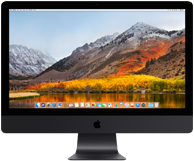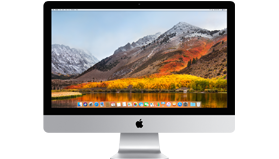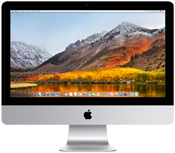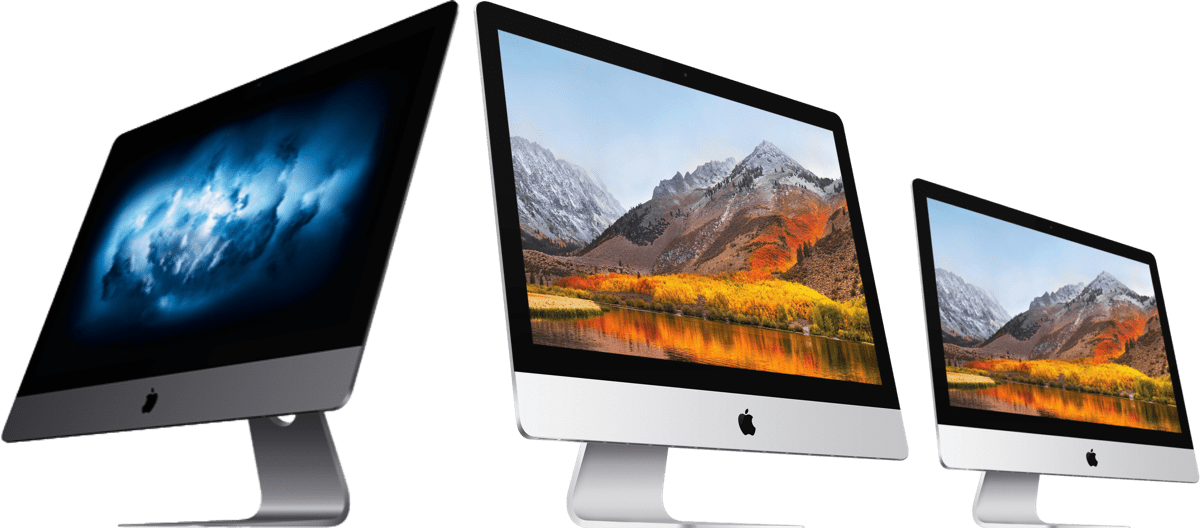This guide – adapted from my own evaluation and decision making process – should cover the most important facts, figures & thoughts you may go through. By the way: it may help you for other Apple Mac models, too.
Facts to check to help your decision making for a new Mac
- 💵 The minimum & maximum budget span you can and want to invest
- 📈 High performance usage of Apps & Games – and how often you use them (once a year, twice a year, monthly, weekly,…)
- 🕹 Amount & type of current must-use and optional external devices
- And if you already own a Mac:
- 📊 Current RAM usage ➞ as shown in “Activity Monitor”
- 💽 Current disk space usage ➞ as shown in “Disk Utility”
 Foreword: remarks regarding the iMac Pro
Foreword: remarks regarding the iMac Pro
So the iMac Pro model is a bit of a special case in my opinion. I think it is only an option if…
- You are looking for a Mac as a business computer for at work – and you do high performance tasks with it on you job on a daily basis
- You are really into gaming (like newest games, on a native Windows installation, playing almost every day) – and somehow you do not want to build yourself a Windows PC
- You have enough money to spend on things without having to have a second thought about it
That’s why this model is not really covered with this guide – as for myself, it was quite quickly “out of scope”, honestly.
💵 Budget to invest in a new iMac
Firstly, get yourself an overview of the base prices of the current iMac models on Apple’s website – and check them against your budget.
Can you sell your current Mac?
If yes, then check online what resellers would pay for your current Mac model, what the current selling fee of same used Macs are at average on platforms like eBay or Amazon ➞ consider the estimated refund amount when defining your budget.
Narrow it down and align it with your budget
With these information, you should be able to narrow down which models are within your budget’s range.


💽 How much Disk space do you need?
Disk types – go for an SSD
Go for SSD (Solid State Drive) – it makes Macs (just as any other computer) much much faster to work with. Everything else – even the Fusion Drive – should not be a primary choice, except when you really don‘t care about longer loading times OR you need a lot of internal Disk space that you don‘t want to upgrade any time soon. But it might be a better investment purchasing an external disk with a USB-C connector to extend your disk space (see section „External devices you need to use“).
One thing though, if you go for a HDD drive: choose a disk running with 7200-rpm (not only 5400-rpm)!
Unexpected additional disk space requirements
Additionally, verify if you have the need for virtualization or booting an installed secondary Operating System (as described in section „Virtualization of or booting into a secondary Operating System“): if you already have this on your current Mac, it will popup when verifying the current Disk space – if you plan to do this on your new iMac, then consider this for evaluating the required disk space.
📊 How much RAM should you configure?
Check your current installed RAM and how much is allocated when running the most often used applications (and games).
- Keep in mind: the 21.5-inch iMac models don‘t allow changing RAM on the fly – you have to take apart the whole iMac to change them
➞ scale the initial configured RAM size with some margin for increased use today; unless are handy and trust in yourself to upgrade them manually - The 27-inch iMac & iMac Pro are a different story: they provide easy access to the RAM slots
➞ don‘t add the expensive RAM upgrades from Apple – but buy them separately and thus cheaper
🕹 External devices you need to use
Be aware that new iMac models only come with USB 3 and USB-C (Thunderbolt 3) ports. If your current external devices, on which you must rely on, don‘t have such connectors, you will need an adapter or a connector hub ➞ Check the required tools and what they cost.
Consider this against your planned budget investment. If they are already USB- or USB-C-compatible, you‘re lucky.
⌨ Permanently connected devices
Check & count the must have – more permanently – connected devices to your current Mac: e.g. Mouse, Keyboard & additional Display to name the most common ones ➞ Check what connector they need and write this down for evaluating the right iMac model.
In terms of secondary displays connected to your – future – iMac: do you have such and will thus be provided with a lot of desktop space anyway? This could mean that a 21.5-inch iMac’s screen size is large enough – if you only will have and work on the iMac itself (without any additional screen), a 27-inch model can be a better option (but make sure you have the space for it as described in section “Physical size of the iMac vs. your desk’s space”).
🎛 Graphics performance
In terms of graphics cards I think the following statements are what matters most:
- Soldered „notebook“ or on-Board graphics cards are less preferred over dedicated cards
(sometimes indicated with an “M” in their model number) - The newer a graphics card model is, the better
- The higher a graphics card‘s model number is (of the same series), the more powerful it is
However, if you are not planning to play games regularly (also in combination with e.g. running windows on your Mac, as explained in the section „Virtualization of or booting into a secondary Operating System“) or you don’t do performance intensive tasks on a regular basis, such as video or photo editing, then you are most likely safe with any of the graphics card built in any of the iMac 21.5- or 27-inch models – and you will definitely NOT need to invest in the iMac Pro.
Powering external displays
Last but not least, do you have or plan to have a 4k or 5k external display connected? Because this also takes a lot of processing power from your Mac’s graphics card. If you do so, a higher model of the available graphics cards are recommended.
iMac graphics cards performance comparison
A very valuable resource is also your current Mac’s graphics card in comparison to the new models of the iMac series: I’d assume that any of them is stronger than what you currently have. Just to make sure, check your “About This Mac > Displays” info and compare your current card vs. the one of the new models on GPUboss:
For example:
- an AMD Radeon HD 6770M (from an iMac 2011 model) vs. the iMac 4k’s AMD Radeon Pro 555
- AMD Radeon Pro 555 (lowest model in new iMacs 4k) vs. AMD Radeon Pro 570 (lowest iMac 5k graphics card)
- AMD Radeon Pro 570 (lowest iMac 5k graphics card) vs. AMD Radeon Pro 580 (highest iMac 5k graphics card)
- AMD Radeon Pro 580 (highest iMac 5k graphics card) vs. Radeon Pro Vega 56 (iMac Pro’s basic graphics card)
👽 Virtualization of or booting into a secondary Operating System
When you have or plan to install & run a secondary Operating System – such as Windows, Linux or another macOS version – then this affects the sizing of the following components:
- Disk space (not only for the OS, but applications and games you want to run with them)
- RAM (more relevant when you want to virtualize, e.g. running it inside macOS)
- Graphics performance (more relevant when you want to virtualize or for running games on other OS platforms)
🖥 Physical size of the iMac vs. your desk’s space
As for sure you have already figured, there is quite a difference in physical size between a 21.5-inch and a 27-inch iMac.
To be more precisely, the specs are as follows:
- 21.5-inch iMac: height 17.7” (45 cm), width 20.8” (53 cm), stand depth 6.9” (17.5 cm)
- 27-inch iMac: height 20.3” (52 cm), width 25.6” (65 cm), stand depth 8” (20.5 cm)
- iMac Pro: height 20.3” (52 cm), width 25.6” (65 cm), stand depth 8” (20.5 cm)
So first of all, look up or measure the size of your current Mac ➞ compare it to the specifications of the new iMac models: does your table provide the necessary space? If you e.g. sit very close to the possible location of the screen, a 27-inch screen might just be too large to comfortably look at and work with this screen size.
💸 Where to buy?
Once you have decided on the specifications for which new iMac to buy, you may now wonder “where to buy it?”.
The most obvious place is of course via Apple’s website.
- ➕ The advantage is, you can configure the specifications of your iMac model however you like and need
- ➖ but it might come with huge additional costs, depending on the upgrades you select.
A good alternative therefore is to check the shops of Apple resellers:
- ➕ they might offer exactly the iMac with the same – or at least very similiar – specifications, as you have in mind
- ➕ and offer them for a better all-in price for it than Apple.
Another option, especially if price is a key criteria for you, is to check used iMacs for sale on auction platforms such as eBay or Amazon.
Conclusion: my own evaluation result & decision
In my opinion – the previously described topics cover the most relevant criteria and circumstances you should consider & compare, when you are planning on buying a new iMac model from Apple.
For myself, I decided to go for an iMac 5k (27-inch) model with the following specs and arguments:
- 🖥 iMac 5k 27-inch model
➞ because it allows easy upgrade of RAM without taking the whole iMac apart - 📈 CPU upgrade to the 3.6GHz quad-core Intel Core i7
➞ because it’s a cost-effective upgrade that I could afford, also looking at my old iMac which – back then – I also updated to an i7 processor and it still provides extremely good CPU performance today - 📊 32 GB of RAM
➞ I would have gone for 8GB (and then buying additional RAM to 16 or 32 GB separately), but one of the Apple resellers offered a cheaper price for a preconfigured iMac 5k with 32 GB RAM, even cheaper if I’d buy additional RAM upgrades myself - 💽 512 GB Solid State Disk (SSD)
➞ becase I already use a 512 GB SSD disk today (speed was key and made all other options out of scope anyway), additionally I already own external disks providing me with additional disk space for less regularly used files and backups. Additionally, I think I will try to move more data to cloud storage in the future, so investing in more disk space capacity was not cost effective for me. - 🎛 the most powerful graphics card of non-iMac Pros: AMD Radeon Pro 580
➞ I do play games sometimes & do video editing on my iMac, so having the highest possible graphics card made me feel more future proof. Also of course the performance comparison showed, that it also delivery more power compared to all the other cards (actually the improvements vs. Radeon Pro 570 and 575 are quite huge). Another point was, that it is again not easy to get & manually change the iMac’s graphics card yourself – so I wanted to have it bumped as much as possible for the coming years. - 🕹 Connections for external devices: this was actually not relevant, as both – the iMac 21.5- and 27-inch have the same amount and type of connectors
As I mentioned already initially, the iMac Pro was very quickly out of consideration for me, due to it’s (high!) price. I think I will be quite happy with a 5k model already, especially compared to the fact that I was still pretty happy about working on my iMac 21-inch model from 2011 😊

